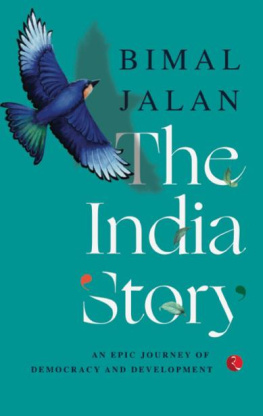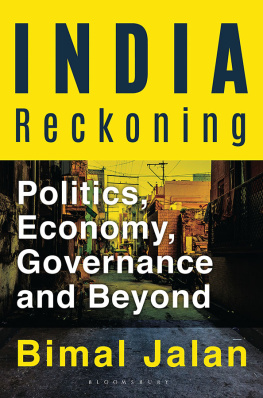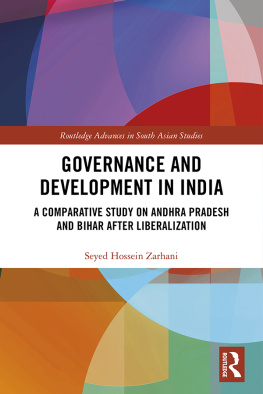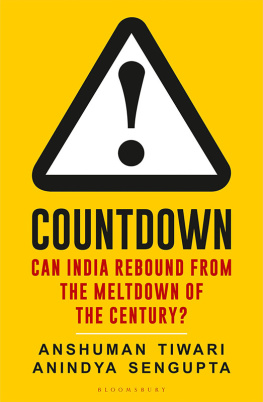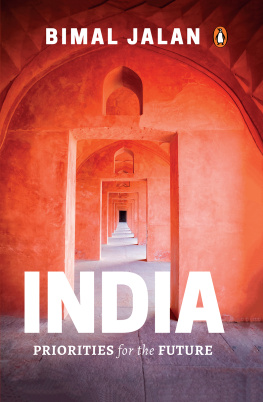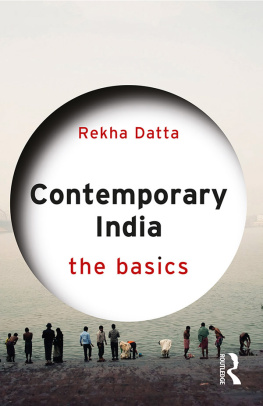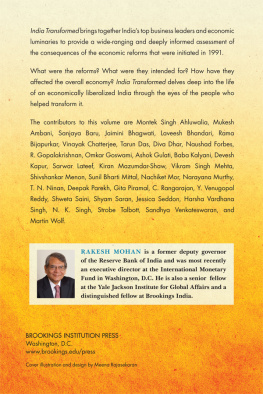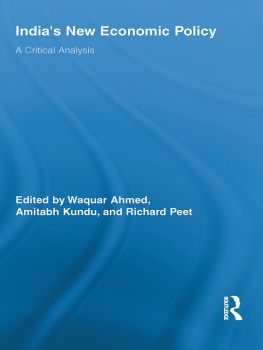Bimal Jalan is one of Indias well-known economists. He was Governor of the Reserve Bank of India from 1997 to 2003, demitting office on his nomination to the Upper House of Parliament by the President for distinguished service to the country. He has held several top positions in the ministries of finance and industry and in the Planning Commission. He was also Chairman of the Economic Advisory Council to the Prime Minister and represented India on the boards of the IMF and the World Bank. He was educated at Presidency College, Calcutta and Cambridge and Oxford universities. His books include Indias Economic Crisis: The Way Ahead (1991), Indias Economic Policy: Preparing for the Twenty-first Century (1996), Indias Economy in the New Millennium (2002), The Future of India (2006) and, as editor, The Indian Economy: Problems and Prospects (Revised edition, 2004).
Notes
1. The Triumph and Travails of Democracy
.
.
. Zakaria, F. (2003), The Future of Freedom, Viking-Penguin, New Delhi.
. Sen, A.K. (2004), Democracy and Secularism in India in Basu, K. (Ed.) Indias Emerging Economy: Performance and Prospects in the 1990s and Beyond, Oxford University Press, New Delhi.
. Przeworski, A. (1995), Sustainable Democracy, Cambridge University Press, Cambridge. Also, Barro, R.J. (1996), Getting It Right: Markets and Choices in a Free Society, The MIT Press, Cambridge, Massachusetts.
.
.
.
.
2. Separation of Powers: The Myth and the Reality
.
.
.
6. After the Crisis: Need for a New Strategy
. Scott, M. (1989), A New View of Economic Growth, Clarendon Press, Oxford. Also Policy Implications of a New View of Economic Growth, The Economic Journal, Vol. 102, No. 412, May 1992.
. Sundrum, R.M. (1990), Economic Growth in Theory and Practice, Macmillan, London.
. Ricketts, Martin (1992), Financial Times, 29 June.
. Ibid.
. Dandekar, V.M. (1992), Forty Years After Independence, in Bimal Jalan (ed.), The Indian Economy, Penguin-Viking, London.
. Jalan, Bimal (1991), Indias Economic Crisis: The Way Ahead, Oxford University Press, Delhi, Chapter V.
8. Indias Economy in the Twenty-First Century: A New Beginning or a False Dawn?
. Gupta, Shekhar (2000), in Indian Express, Mumbai, 11 November.
. Krugman, Paul (1999), The Return of Depression Economics, The Penguin Press, London.
. Lewis, W.A. (1954), Economic Development with Unlimited Supplies of Labour, Manchester School, Vol. 22.
. It may be mentioned that some parts of the public sector, particularly oil and telecommunications have been quite profitable. This partly reflects their erstwhile monopoly position and the administered price regimes. These profitable sectors have been largely self-financing without the need for budget transfers.
. Hanson, A.H. (1963), The Crisis of Indian Planning, Political Quarterly, OctoberDecember, reprinted in Hanson, A.H. (1969), Planning and Politicians, Routledge and Kegan Paul, London.
. Parikh, Kirit (1999), Economy, in India BriefingA Transformative Fifty Years, M.E. Sharp Incorporated for Asia Society, New York. Parikhs per capita income forecasts assume a dollarrupee exchange rate based on purchasing power parity.
. Rosensweig, J.A. (1998), Winning the Global Game, The Free Press, New York. Rosensweigs forecasts are also on purchasing power parity basis.
9. Indias Record in the Social Sectors
. Sen, A.K. (1993), The Economics of Life and Death, Scientific American, May.
. Kannan, K.P. (1995), Declining Incidence of Rural Poverty in Kerala, Economic and Political Weekly, 1421 October, p. 2661. In Kerala, real per capita social expenditure actually declined during the period from 1986 to 1992 compared with a growth of about 5 per cent per annum during 197585. See Social Indicators of Development for India, Economic and Political Weekly, 21 May 1994.
. UNDP (1994), Human Development Report 1994, Oxford University Press, New York.
. Prabhu, K.S., and S. Chatterjee (1993), Social Sector Expenditures and Human Development: A Study of Indian States, Reserve Bank of India, Bombay. See also Social Indicators of Development for India, cited above.
. Chakrabarty, G., and S.P. Pal (1995), Human Development Profile of Indian States, National Council of Applied Economic Research, New Delhi.
. Human Development Report 1994, cited above.
. Social Indicators of Development-I, Economic and Political Weekly, 14 May 1994.
. Blyn, G. (1966), Agricultural Trends in India, 1891-1947, Pennsylvania University Press, Philadelphia.
. For a review of the literature on provision of social services, see Murthy, N., et al., How Well Do Indias Social Service Programs Serve the Poor, Working Paper 491, World Bank, Washington DC. Examples cited in the text relating to access of the poor to social services are from this study. Figures of purchases from the public distribution system are from Ravallion M., and K. Subba Rao (1991), Adjustment and Human Development in India, Journal of Indian School of Political Economy, Vol. 4.
. Prabhu, K.S., and S. Chatterjee, cited above.
. The results of an analysis covering the states of Bihar, Orissa and Madhya Pradesh showed that the weighted average prices paid by the poor for foodgrains were higher than what they would have paid in the absence of public procurement. In these states, only a very small proportion of the per capita requirement of foodgrains of the poor was met through the fair price shops. See Tyagi, D.S. (1990), Managing Indias Food Economy: Problems and Alternatives, Sage Publications, Delhi.
. Swaminathan, M. (1995), Revamped Public Distribution System: A Field Report from Maharashtra, Economic and Political Weekly, Vol. 30, 9 September.
. There is now an extensive literature on the so-called New Growth Theories which give prime importance to human resource endowments, as distinguished from physical capital formation, in explaining growth performance among countries. See Psacharopoulos, G. (1984), The Contribution of Education to Economic Growth: International Comparisons, in Kendrick, J.W. (ed.), International Comparisons of Productivity and Causes of the Slowdown, Ballinger, Cambridge. Also see Lucas, R. (1988), On the Mechanics of Economic Development, Journal of Monetary Economics, Vol. 22, and Barro, R.J. (1991), Economic Growth in a Cross-Section of Countries, Quarterly Journal of Economics.
. All the figures on literacy rates in India are taken from the Government of India publication Education for All: The Indian Scene


